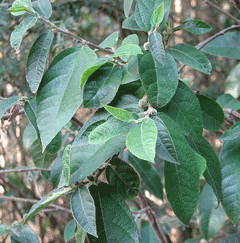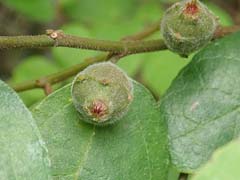 |
|
http://en.wikipedia.org/wiki/User:Melburnian |
 |
| MargaretRDonald wikimedia.org |
Translate this page:
Summary
Physical Characteristics

 Ficus coronata is a TREE growing to 12 m (39ft) by 4 m (13ft).
Ficus coronata is a TREE growing to 12 m (39ft) by 4 m (13ft).
See above for USDA hardiness. It is hardy to UK zone 9. The species is hermaphrodite (has both male and female organs) and is pollinated by Insects.
Suitable for: light (sandy), medium (loamy) and heavy (clay) soils. Suitable pH: mildly acid, neutral and basic (mildly alkaline) soils. It can grow in semi-shade (light woodland) or no shade. It prefers moist soil and can tolerate drought.
UK Hardiness Map
US Hardiness Map
Synonyms
F. muntia (link). F. stephanocarpa (Warb).
Plant Habitats
Woodland Garden Sunny Edge;
Edible Uses
Edible Parts: Fruit
Edible Uses:
Edible and palatable fruit 2cm in size eaten fresh (remove the furry skin) or dried that is green when unfertilised, and darkening to a purple/black when mature. Fruits ripen from January to June. Use cooked in cakes, pies, biscuits, jellies, jams or sauces. A very sweet fruit said to be the best tasting Australian fig (tuckerbush.com.au).
References More on Edible Uses
Medicinal Uses
Plants For A Future can not take any responsibility for any adverse effects from the use of plants. Always seek advice from a professional before using a plant medicinally.
In herbal medicine, the sap is applied to small sores and warts (tooheyforesteec.eq.edu.au).
References More on Medicinal Uses
The Bookshop: Edible Plant Books
Our Latest books on Perennial Plants For Food Forests and Permaculture Gardens in paperback or digital formats.

Edible Tropical Plants
Food Forest Plants for Hotter Conditions: 250+ Plants For Tropical Food Forests & Permaculture Gardens.
More

Edible Temperate Plants
Plants for Your Food Forest: 500 Plants for Temperate Food Forests & Permaculture Gardens.
More

More Books
PFAF have eight books available in paperback and digital formats. Browse the shop for more information.
Shop Now
Other Uses
Hedge Houseplant Sandpaper Soil stabilization
Leaves used as sandpaper. Aboriginal people traditionally used the leaves to smooth and polish weaponry, the bark to make string (tuckerbush.com.au). The fruit is a food plant for the caterpillars of the Queensland butterfly the common- or purple moonbeam (Philiris innotatus), the Australasian figbird (Sphecotheres vieilloti), green catbird (Ailuroedus crassirostris), olive-backed oriole (Oriolus sagittatus), topknot pigeon (Lopholaimus antarcticus), and grey-headed flying fox (Pteropus poliocephalus). Tolerate heavy pruning. good hedge plant. A good canopy shade tree. An excellent bonsai or small indoor potted tree. Ideal for stream bank stabilization.
Special Uses
Hedge
References More on Other Uses
Cultivation details
A medium sized tree of up to 15m tall. It has rough, densely hairy branches and leaves. A hardy species, tolerating colder climates, poor soils, and poor light conditions. It does not tolerate frosts very well, particularly when young. Prefers plenty of light, space and moisture, in warmer climates free from frosts. An aggressive root system characteristic of Ficus species can cause issues with plumbing, concrete paths and structural foundations. Grows densely in full sun, less so in shade. Pollinated by co-dependant species of fig wasp. Low maintenance.
References Carbon Farming Information and Carbon Sequestration Information
Temperature Converter
Type a value in the Celsius field to convert the value to Fahrenheit:
Fahrenheit:
The PFAF Bookshop
Plants For A Future have a number of books available in paperback and digital form. Book titles include Edible Plants, Edible Perennials, Edible Trees,Edible Shrubs, Woodland Gardening, and Temperate Food Forest Plants. Our new book is Food Forest Plants For Hotter Conditions (Tropical and Sub-Tropical).
Shop Now
Plant Propagation
Fresh seeds, or cuttings taken from the growing tip of a live plant.
Other Names
If available other names are mentioned here
Sandpaper fig, Creek sandpaper fig. Ficus - from the Latin ficus, meaning “edible fruit”. coronata - from the Latin coronatus, meaning “crowned”, referring to the crown of bristles at the tip of the fig
Native Range
AUSTRALASIA: Australia, New South Wales (east), Queensland (east), Victoria (east), Northern Territory (northeast),
Weed Potential
Right plant wrong place. We are currently updating this section.
Please note that a plant may be invasive in one area but may not in your area so it's worth checking.
Conservation Status
IUCN Red List of Threatened Plants Status : In eastern Victoria, it is listed as "threatened" under the Flora and Fauna Guarantee Act 1988.

Growth: S = slow M = medium F = fast. Soil: L = light (sandy) M = medium H = heavy (clay). pH: A = acid N = neutral B = basic (alkaline). Shade: F = full shade S = semi-shade N = no shade. Moisture: D = dry M = Moist We = wet Wa = water.
Now available:
Food Forest Plants for Mediterranean Conditions
350+ Perennial Plants For Mediterranean and Drier Food Forests and Permaculture Gardens.
[Paperback and eBook]
This is the third in Plants For A Future's series of plant guides for food forests tailored to
specific climate zones. Following volumes on temperate and tropical ecosystems, this book focuses
on species suited to Mediterranean conditions—regions with hot, dry summers and cool, wet winters,
often facing the added challenge of climate change.
Read More
Expert comment
Author
Spin.
Botanical References
265
Links / References
For a list of references used on this page please go here
Readers comment
© 2010, Plants For A Future. Plants For A Future is a charitable company limited by guarantee, registered in England and Wales. Charity No. 1057719, Company No. 3204567.